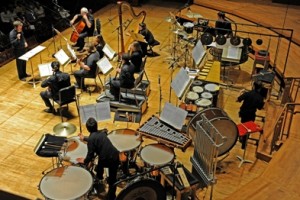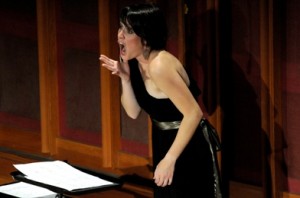
TMC Fellows perform world premiere of John Zorn's 'À Rebours' with solo cellist Fred Sherry and Ensemble Signal conductor Brad Lubman (photo Stu Rosner)
TANGLEWOOD
Festival of Contemporary Music
Fromm Concert
Ozawa Hall
Thursday, August 4, 2011
Review by Seth Rogovoy
(LENOX, Mass.) – A mostly brilliant evening of new and recent compositions was capped by the debut of John Zorn’s dazzling À Rebours, a fun-house ride and reverie featuring solo cellist Fred Sherry and nine players, including three percussionists playing several dozen instruments on a 10-minute piece so chock full of twists and turns and musical surprises a listener immediately wanted to hear it again upon its conclusion.
That’s not always the case with new pieces, but Zorn loaded this densely packed work, a memorial to composer György Ligeti (to whom this critic tied Zorn in a review of an improvisational concert with Lou Reed and Laurie Anderson a year ago in Montreal), with so much stuff that it’s impossible to do justice to it after just one hearing – a hearing to which the audience responded enthusiastically, demanding at least three curtain calls for Zorn and the players, in an evening that otherwise did much to entertain, tickle and provoke.
Zorn’s work, which takes its title from the pathbreaking 1884 novel by the French writer J.K. Huysmans, was always in motion, with the focus moving from cello to plucked strings, tolling bells, shotgun-like snare drum bursts, rumbling tympanis, angelic harp, back to buzzing cello. It was at once skittish and lyrical, anxious and reassuring, alarming and rib-tickling.
Bookending Zorn’s piece, which concluded the evening, was Fred Ho’s new Fanfare to Stop the Creeping Meatball. Kicking off each concert of this year’s Festival of Contemporary Music, the too-short piece was a little bit Henry Mancini, a lot of Carl Stalling, prankish and playful (the trumpeter even made fart-noises on his arm), and perfectly suited to the occasion.
Tobias Picker’s 1977 work, Sextet No.2, Halle’s Ravine, featured a sextet drawn from Ensemble Signal – which functioned for the most part as the house band for the evening — divided into three pairs: two strings, two clareints, and two resonant percussion instruments (piano and vibraphone). There was no place for the musicians to hide here, and the ensemble played with incredibly taut precision, as a note began on one instrument and flowed through the next and resolved in a third. It was a virtuosic display and much credit for it devolves to conductor Brad Lubman, who almost viscerally was playing the sextet itself.
Jason Eckardt’s dark, brooding Rendtion, for bass clarinet and piano, alluded to that nefarious practice of the U.S. government of handing over suspected terrorists to nations with much lower standards of human rights, knowing full well they will be tortured. The work began with long, low, ominous notes played by the Bill Kalinkos on bass clarinet, slowly modulating and matched by Oliver Hagen on piano. At first it was soft and dreamlike, and Kalinkos climbed up the register, until Hagen suddenly started pounding his keyboard with staccato attacks like gunshots.
Nine members of Ensemble Signal joined forces with Lubman for Brian Ferneyhough’s Terrain for solo violin and chamber ensemble, featuring violinist Christopher Otto, who played two simultaneous solo lines while the rest of the group joined in with bits of polyphony and cacophony. When the brass section came in toward the end, they played what could have been a interstellar conversation, reminiscent as it was of John Williams’s imagined Mother Ship theme from Close Encounters of the Third Kind.
Fred Sherry opened the second half of the program with one of Milton Babbit’s final compositions, his More Melismata for solo cello, written in 2006 when Babbit was about 90 years old.
Before the Zorn piece closed the evening, composer John Chowning “performed” his Voices, for soprano and electronics (2005), with vocalist Amy Petrongelli. Chowning sat in the house, manning the electronics at the soundboard, while Petrongelli commanded all attention and focus with her phenomenal presence, choreography, and voice. She didn’t just stand and sing; this was art song rendered dramatically, nearly operatically, making use of the entire stage as well as full gestures and emotions. Petrongelli sang and improvised along to Chowning’s score, which was at once organic, drawing its tones from gongs and chimes and bells, while at the same time futuristic, with their nod toward hi-tech computer sounds. At times Petrongelli’s vocals were manipulated so they echoed, reverberated, resonated, and so that she sounded like a siren, in both meanings of the word.
In the end, though, it was the Zorn work that rocked the casbah, and that cried out for an encore, as in, literally, again.
Seth Rogovoy is an award-winning music critic and the author of The Essential Klezmer: A Music Lover’s Guide to Jewish Roots and Soul Music and Bob Dylan: Prophet Mystic Poet.

